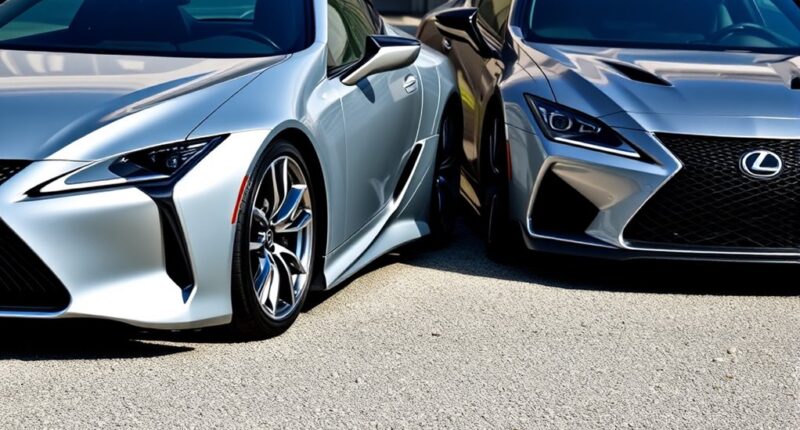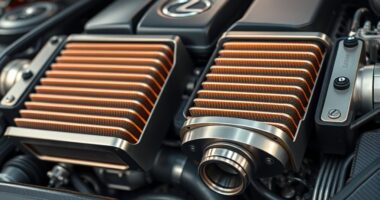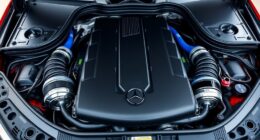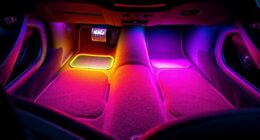Lexus offers advanced aerodynamic packages for both the LC 500 and RC F to enhance stability, handling, and high-speed performance. These include active spoilers, diffusers, canard vortex generators, and side extensions made from lightweight carbon fiber or FRP. Upgrades like the E6 Carbon Elite Kit or Aero Dynamics Kit optimize airflow and downforce, improving cornering and stability. Exploring further reveals how these modifications can truly elevate your driving experience.
Key Takeaways
- Lexus offers aerodynamic packages like the E6 Carbon Elite Kit and NOVEL Aero Dynamics Kit to enhance high-speed stability.
- Features include active front spoilers, rear diffusers, canard vortex generators, and active rear wings for optimized downforce.
- Custom options with carbon fiber, FRP, or lightweight materials improve handling, reduce weight, and refine airflow management.
- Aero components can be integrated with drive modes to boost cornering grip, stability, and overall vehicle control.
- Special editions such as the LC 500 Aviation Edition showcase exclusive aerodynamic elements for performance and style.
Key Aerodynamic Design Elements of Lexus LC 500 and RC F
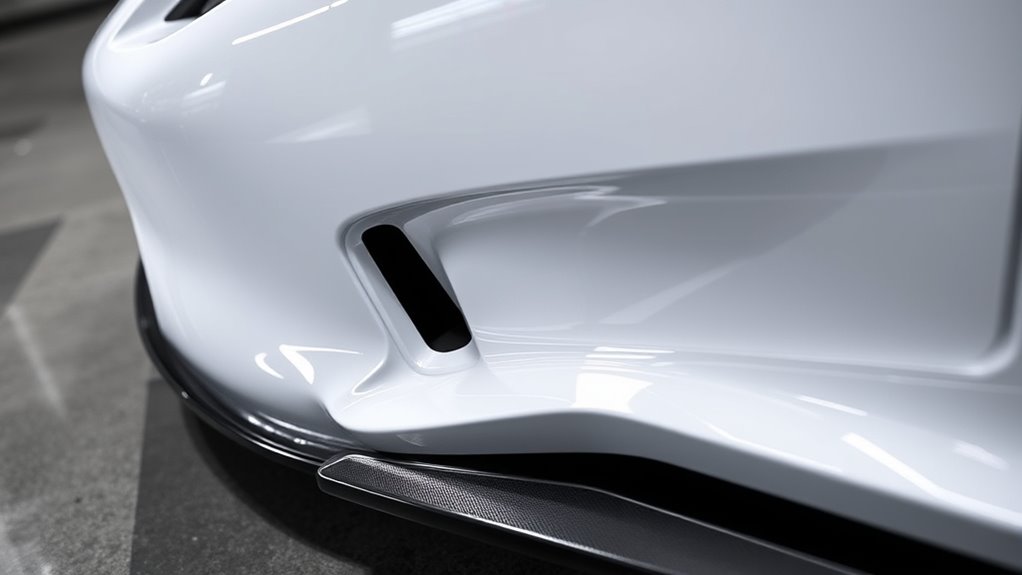
The key aerodynamic design elements of the Lexus LC 500 and RC F focus on maximizing airflow to enhance performance, stability, and efficiency. You’ll notice the active front spoiler, which increases downforce and improves steering at high speeds. Canard vortex generators reduce lift by managing airflow around the corners, while the splitter lip spoiler minimizes front lift, boosting stability. Wider grille openings enhance cooling without sacrificing aerodynamics. Carbon fiber components lower weight and improve airflow efficiency. At the rear, an active rear wing adjusts automatically for ideal downforce, and stabilizing fins help decrease drag. The rear diffuser channels airflow underneath, reducing turbulence. Underbody panels and side extensions accelerate airflow beneath the vehicle and manage turbulence around the wheels. These elements work together to deliver a sleek, performance-focused aerodynamic profile. Additionally, the integration of aerodynamic elements ensures optimal airflow management for enhanced vehicle dynamics. Proper aerodynamic design not only improves handling but also contributes to fuel efficiency and overall driving performance. Understanding the importance of vehicle aerodynamics can lead to better tuning and customization for specific driving conditions. Incorporating advanced aerodynamic features can further optimize the vehicle’s performance across various driving scenarios. Moreover, employing computational fluid dynamics analysis allows engineers to refine these features for maximum effectiveness.
Performance-Enhancing Packages and Their Impact on Aerodynamics
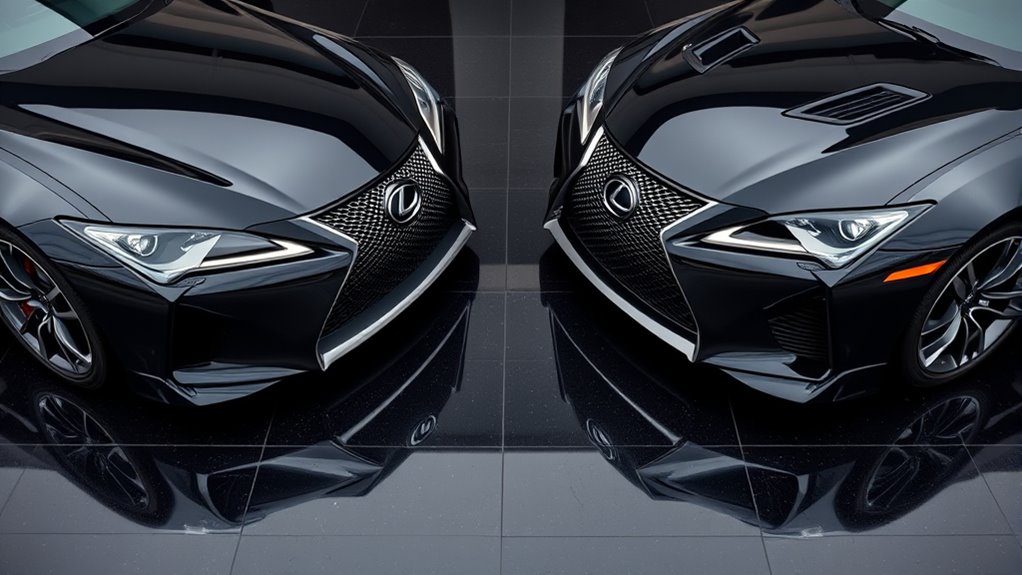
Performance-enhancing packages for the Lexus LC 500 markedly boost aerodynamic capabilities, refining airflow management to improve handling and stability at high speeds. The E6 Carbon Elite Kit, with its carbon fiber front splitter, side splitters, and rear diffuser, increases downforce and handling by optimizing airflow. The NOVEL Aero Dynamics Kit maintains OEM lines while enhancing aerodynamic efficiency through refined contours, including a front lip, side skirts, and rear under spoiler. The Aviation Edition spoiler, with its curved carbon fiber winglets, reduces turbulence and sharpens steering response. Most kits offer carbon fiber or FRP options, balancing weight savings and cost. Custom-made designs ensure precise fitment, allowing you to enhance performance without compromising style. These upgrades collectively improve high-speed stability, downforce, and feedback, making your LC 500 more track-ready.
Comparing Aero Features Between LC 500 Convertible and RC F Models

Although both the Lexus LC 500 Convertible and RC F prioritize aerodynamics, their body styles and design elements create notable differences in airflow management. The convertible’s soft-top design impacts airflow, unlike the coupe’s fixed roof of the RC F, which offers better aerodynamic efficiency. The RC F features a more aggressive front bumper with larger air intakes for enhanced cooling and airflow, while the LC 500’s smoother front end emphasizes style. Side skirts and rear diffusers on the RC F are more pronounced, improving downforce and reducing turbulence. Additionally, the RC F’s rear spoiler is typically more prominent, boosting high-speed stability. Incorporating antique-inspired design elements can also add a distinctive touch to the overall aesthetic of these models.
Weight Reduction Strategies to Improve Aero Efficiency

Implementing weight reduction strategies is essential for enhancing aerodynamic efficiency in modern Lexus models. Using lightweight materials like carbon fiber-reinforced polymer for body panels reduces mass while maintaining rigidity. Aluminum alloy subframes and suspension components lower unsprung weight, boosting handling and aero responsiveness. Polycarbonate rear windows replace glass to cut weight without sacrificing visibility. Titanium exhaust systems decrease rear-end mass and improve exhaust flow. Magnesium alloy wheels reduce rotational inertia and rolling resistance. Structural design optimizations, such as hollow-core anti-roll bars and streamlined underbody panels, lower weight and drag. Integrated spoiler designs and lightweight actuators enhance downforce and airflow control. Interior components like carbon fiber seat frames and resin-molded composites cut mass without compromising comfort or safety. Additionally, utilizing headphones with low latency and wireless capabilities can improve driver focus and in-car entertainment experience. Incorporating advanced lightweight materials in chassis design further enhances overall efficiency and performance. Furthermore, aerodynamic testing plays a crucial role in validating these weight reduction strategies to ensure optimal vehicle performance. Employing knowledge of materials helps identify the best options for balancing weight savings with durability and safety. Staying updated on AI security vulnerabilities and safety measures can inform the development of smarter, more resilient vehicle systems. These strategies collectively improve aero efficiency by reducing overall vehicle weight.
Drive Mode Integration and Its Effect on Aerodynamic Balance
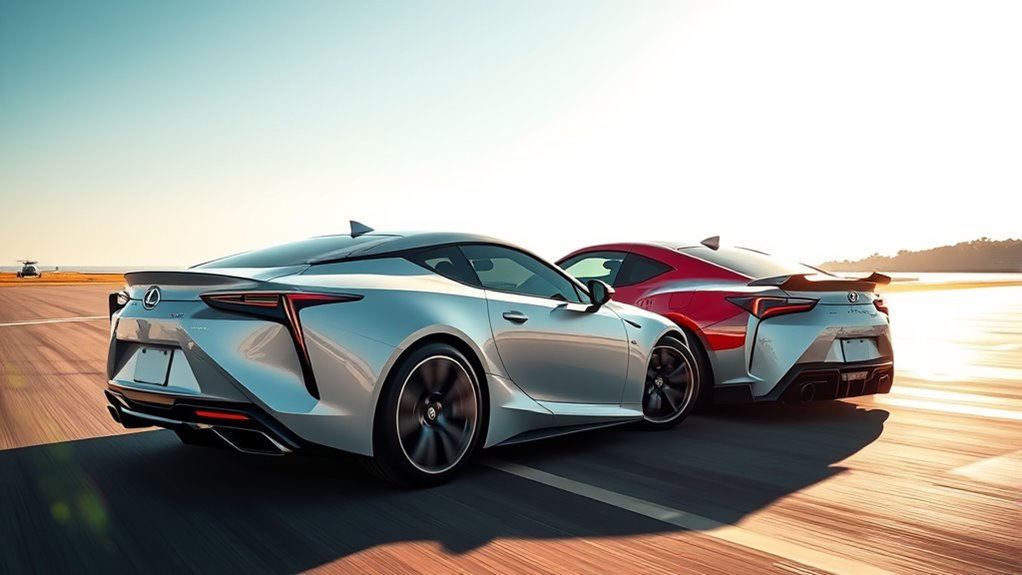
Drive mode selection directly influences the aerodynamic balance of Lexus LC 500 and RC F by electronically adjusting components like spoilers, diffusers, and air intakes. When you switch modes, you alter the aero profile to suit driving conditions, from increased downforce in Sport+ to reduced drag in Comfort. Sport modes raise fixed aero components, lower the suspension, and boost stability for high-speed cornering. Comfort mode emphasizes efficiency with a neutral aero stance. Some models let you customize modes via aftermarket ECU tuning, fine-tuning aero behavior to your preferences. Additionally, hybrid variants optimize airflow for battery cooling, especially in EV modes. Energetic alignment can also play a role in optimizing your vehicle’s performance and your driving experience. Incorporating aerodynamic customization options enables drivers to further tailor their vehicle’s behavior for specific driving scenarios. Understanding aero efficiency principles can help you make more informed adjustments to enhance overall handling and fuel economy. Proper aerodynamic design can significantly impact vehicle stability and efficiency at various speeds, especially when combined with risk assessment to prevent potential issues related to new technologies.
Customization Options for Enhanced Aerodynamic Performance

You can enhance the Lexus LC 500 or RC F’s aerodynamic performance through various customization options that blend form and function. These kits typically include front splitters, side skirts, rear diffusers, and spoilers, all designed to improve airflow and stability. Material choices like carbon fiber and FRP ensure lightweight durability, while custom designs enhance both style and function. Special editions, such as the LC 500 Aviation Edition, showcase unique aerodynamic features. You can select options that reduce drag, generate downforce, and improve handling. Incorporating aerodynamic performance features tailored to your vehicle can lead to better fuel efficiency and driving dynamics. Additionally, understanding market fluctuations can help inform the timing of your upgrades for optimal results. Paying attention to seasonal trends in automotive accessories can also maximize the benefits of your customization efforts.
Benefits of Advanced Aero Features on Handling and Stability

Advanced aero features substantially boost handling and stability by increasing downforce and optimizing airflow around the vehicle. This results in better tire grip during high-speed cornering and reduces lift, keeping you more grounded. Enhanced airflow management minimizes drag and turbulence, improving overall performance. The use of lightweight carbon fiber components, like rear wings and hoods, lowers weight without sacrificing strength, further enhancing handling. Precise engineering ensures these features deliver predictable, consistent responses without compromising comfort or luxury.
- Increase tire grip and cornering control
- Improve high-speed stability and predictability
- Reduce weight while maintaining structural integrity
Frequently Asked Questions
How Do Aerodynamic Features Influence Overall Vehicle Fuel Efficiency?
Aerodynamic features directly impact your vehicle’s fuel efficiency by reducing drag and improving airflow. When you incorporate streamlined shapes and active components like adjustable spoilers, your car faces less air resistance, making it easier to move. This means your engine works less hard, saving fuel. Additionally, lightweight materials and underbody treatments further enhance efficiency by minimizing turbulence and weight, helping you enjoy better mileage and performance.
Can Aftermarket Modifications Improve the Factory Aerodynamics of These Models?
They say a chain is only as strong as its weakest link, and the same applies to your car’s performance. Aftermarket modifications can definitely improve your vehicle’s factory aerodynamics by adding components like diffusers and side skirts that enhance downforce and stability. With proper upgrades, you’ll notice better handling at high speeds and a more aggressive stance, turning your ride into a true performance machine.
What Maintenance Is Required to Preserve Aero Components’ Performance?
To keep your vehicle’s aerodynamic components performing well, you need regular inspections for damage, debris, and loose fasteners. Clean air ducts and vents, avoid high-pressure washes on flexible parts, and promptly repair scratches or dents. Lubricate moving parts like active shutters, apply UV protectant on carbon-fiber surfaces, and check alignment and calibration. Maintaining these elements ensures ideal airflow, stability, and efficiency, prolonging the life of your vehicle’s aerodynamic features.
How Do Aero Packages Affect the Vehicle’S Noise Levels During Driving?
Ever wonder how aero packages influence your driving experience? They’re designed to reduce turbulence and wind noise, making your ride quieter and more stable at high speeds. You’ll notice less buffeting around windows and smoother airflow over the body. These enhancements not only cut down noise levels but also improve handling, giving you a confident, serene drive. With proper maintenance, you’ll enjoy the full benefits of these aerodynamic improvements every time you hit the road.
Are There Specific Driving Conditions Where Aero Features Provide the Most Benefit?
You’ll find aero features most beneficial during high-speed driving, especially on the highway or racetrack. They reduce lift, improve stability, and enhance grip, giving you more control during sharp turns or sudden maneuvers. When conditions are windy or crosswinds are strong, these features also help counteract turbulence, keeping your vehicle steady. Overall, aero enhancements boost safety and performance when you push your car to its limits in demanding driving environments.
Conclusion
So, now you know that adding all those flashy aero parts turns your Lexus into a jet on wheels—because who needs practicality when you can have the latest spoilers and diffusers? Just remember, all these upgrades might make you look fast, but they won’t turn your daily driver into a race car overnight. Still, it’s fun to pretend, right? After all, isn’t style just the art of fooling everyone into thinking you’re a pro?
